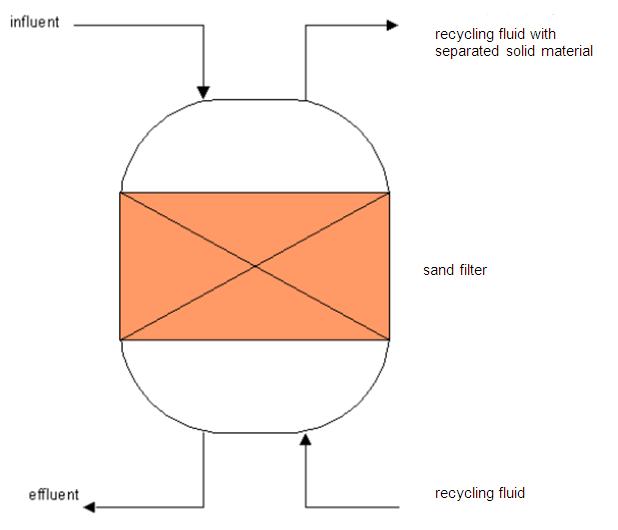Method diagram
Method and installation description
Sand filtration is used for the removal of suspended matter, as well as floating and sinkable particles. The wastewater flows vertically through a fine bed of sand and/or gravel. Particles are removed by way of absorption or physical encapsulation. If there is excessive pressure loss on the filter, it must be rinsed.
A distinction can be made between continuous and discontinuous filters. In continuous filters (often upward-flowing filters), the polluted sand is removed, rinsed and re-used continuously, without interrupting the filtration process. Discontinuous filters (often downward-flowing filters) are stopped, and a rinse takes place in the opposite direction. Air bubbles are blown into the sand bed to make it swirl around. Filtered water then flows through the filter bed in the opposite direction. The polluted matter is released and flows away along with the rinse water. The filtration process can then resume.
The yield of a sand filter is determined by two sand filter functions, namely surface filtration and depth filtration. Surface filtration involves collecting the particles above the filter bed. These particles jointly form a macro-porous lump, which is able to collect new particles in a very effective manner. Depth filtration generally involves smaller particles that are more difficult to collect, and which are bound to the sand particles by adsorption. Dirt from surface filtration is easier to remove during reverse rinsing compared to dirt from depth filtration.
Specific advantages and disadvantages
The main benefit of a sand filter is the simple system which, in many cases, can be used to obtain considerable yields. A sand filter can be placed in various phases of water management - as a pre-treatment, as side-stream filtration and as a polishing filter. A sand filter often provides an effluent with potential for re-use.
However, chemicals sometimes need to be added to improve the yield of the sand filter. A disadvantage of sand filtration is the rinse water that is created when the sand filter is cleaned. This heavily polluted water must be treated and disposed of. To limit the load on the filter, a preliminary sedimentation step is implemented for heavily loaded wastewaters (a lot of suspended and sinkable matter). This helps to avoid repetitive re-rinsing of the filter.
Discontinuous sand filters are often placed in parallel set-up in order to keep the process running when one of the filters is being cleaned.
Application
Sand filters are used in various sectors and processes, where far-reaching removal of suspended matter from water or wastewater is required.
Sectors where sand filtration is implemented include drinking water production, swimming pools, car washes, groundwater treatment, RWZI, slaughterhouses, fruit and vegetable processing industry, drinks, food industry, surface treatment of metals, …
Cooling water production, drinking water preparation, pre-filtration in active carbon treatments and membrane systems, and the filtration of swimming pool water.
Below are a few implementation examples:
- Iron-removal from groundwater using aeration and sand filtration.
- Final purification of wastewater, follow-up to metal precipitation and sedimentation, to remove residual traces of metal-based sludge.
- Final purification of wastewater produced in the production of iron, steel and non-ferro alloys. Sand filtration can be preceded by processes like precipitation/sedimentation, coagulation/flocculation/sedimentation and flotation.
- Purification of wastewater containing sand-blasting grit and paint particles, at shipyards for example.
- Also used as final purification (or prior to active carbon filtration) to permit re-use.
- Used in greenhouse horticulture as drain-water disinfectant (slow sand filter)
Boundary conditions
The hydraulic speed of discontinuous sand filters varies between 3 and 20 m3/m2/hour, with an average of approximately 10 m3/m2/hour. The flow speed is determined by the desired end result. Slow sand filters have a surface load of 0.1-0.2 m³/m²/hour. Continuous sand filters have a hydraulic speed of 5-10 m3/m2/hour.
Effectiveness
Sand filtration is primarily used for the removal of suspended matter. The yield in this case varies between 50 and 99.99%, depending on whether support aids are used.
In addition to suspended matter, COD, BOD, organically bound nitrogen and phosphate, and undissolved metals are also removed from the wastewater.
Support aids
A coagulant/flocculant could possibly be added in advance to improve the yield.
Environmental issues
A water flow containing large quantities of waste material will be created during the re-rinse phase. This flow must be treated or disposed of, which is accompanied by extra costs. In some cases, this rinse water can be put to good use, e.g. rinse water from iron removal can be used in chemical dephosphatisation.
Cost
The investment cost for a polyester sand filter of 12 m³/h for a swimming pool (48 to 60 m³) amounts to € 550-600.
An industrial continuous sand filter of 5 m² or approximately 50m³/h costs around € 50.000. Running costs are very low because of its simplicity and the limited maintenance.
Comments
Bio-mass may grow on the grains of a slow sand filter, whereby biological activity may occur in the sand filter. A slow sand filter is used as a disinfection technique in greenhouse horticulture.
Complexity
Sand filtration is a relatively simple process.
Level of automation
The system is easy to automate. Continuous sand filters only require limited automation (loss of pressure, alarms). In discontinuous sand filters, the rinse cycle must be automated and activated by a measured loss of pressure or on a time basis.
References
- EIPPCB, Reference Document on BAT in Common Waste Water and Waste Gas Treatment / Management Systems in the Chemical Sector, draft February 2009 (revision upon release)
- VITO-SCT, revision of technical notes WASS, 2009
Version February 2010


